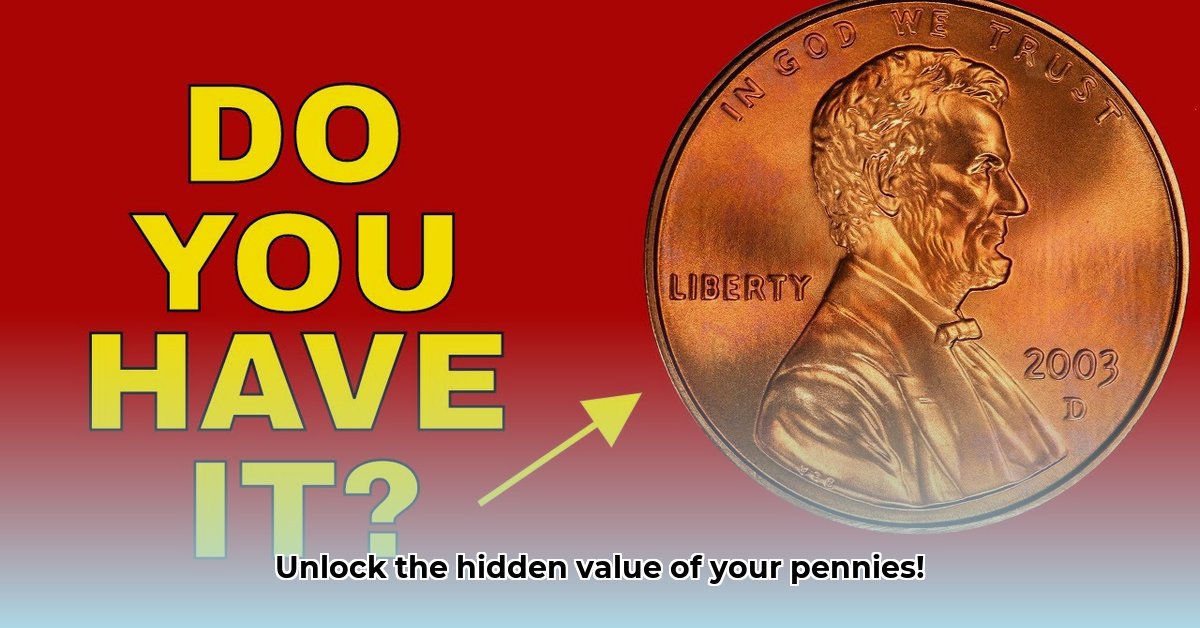
Understanding the 2003-D Lincoln Cent: More Than Just a Penny
The 2003-D Lincoln cent, minted in Denver, Colorado, is a familiar sight. Over 3.5 billion were produced, making it a common coin. However, its value far surpasses its face value for certain specimens. The key to unlocking its potential worth lies in understanding coin grading and the factors influencing collector demand. This guide provides a comprehensive overview, equipping both novice and experienced collectors with the knowledge to assess their own 2003-D pennies.
Coin Grading: The Cornerstone of Value
The Sheldon Scale, ranging from 1 (Poor) to 70 (Perfect), is the industry standard for coin grading. This scale reflects the coin's condition, with higher grades indicating better preservation. A near-mint state 2003-D penny (MS65 or higher) commands significantly more than a well-worn circulated coin. Think of it like a car – a new car is worth far more than one that's been driven for years.
[This section would ideally include a visual representation of the Sheldon grading scale.]
Factors Influencing 2003-D Penny Value
Several elements determine a 2003-D penny's value beyond its grade:
Rarity: While the overall mintage is high, variations in production across mints can create relative rarity, boosting value. A well-preserved 2003-D penny is potentially more valuable than a similarly graded 2003-P (Philadelphia) coin.
Market Demand: Collector interest fluctuates, influencing prices. Increased demand drives up values, while decreased interest may lead to lower prices.
Minting Errors: Doubled dies, off-center strikes, or other anomalies dramatically increase a coin's value. These errors are highly sought after by collectors and can make a penny worth hundreds or even thousands of dollars.
Estimating Value: A Range of Possibilities
Precise valuation is challenging. Online resources may provide estimates, but these vary widely. A professional grading from reputable services like PCGS or NGC is essential for accurate valuation and ensures the highest possible sale price. The grade significantly influences the price— a high-grade coin can be worth several dollars, while a circulated coin remains at its face value. Why is professional grading so crucial? Because it provides an objective assessment of the coin's condition, removing subjectivity and ensuring fair market value.
Buying, Selling, and Storage: Practical Tips for Collectors
Buying:
- Purchase from reputable sources like established coin dealers or auction houses.
- Verify authenticity carefully to avoid counterfeit coins. Professional authentication is recommended for high-value coins.
Selling:
- Professional grading is crucial for maximizing selling price.
- Research current market values to determine a fair asking price.
Storage:
- Protect your coin using air-tight cases to prevent damage from moisture and scratches, preserving its condition and value. Proper storage is an investment that protects your investment.
Investment Potential: Risks and Rewards
Investing in coins involves risk. While some 2003-D pennies can appreciate significantly, especially error coins or high-grade specimens, the market's volatility necessitates a long-term perspective. Don't expect overnight riches. Diversification within your coin collection is a wise strategy to mitigate risk. What's the likelihood of a significant increase in value? That depends on many factors including market trends, collector interest, and the coin's condition.
Risk Assessment Matrix
| Risk Factor | Likelihood | Impact | Mitigation Strategy |
|---|---|---|---|
| Counterfeits | Moderate | High | Buy from reputable sources; obtain professional authentication. |
| Market Volatility | Moderate | Moderate | Diversify your collection; closely monitor market trends. |
| Inaccurate Grading | Low | Moderate | Use only established, reputable grading services. |
| Improper Storage | Moderate | Moderate | Employ high-quality, archival storage solutions. |
Conclusion: Your 2003-D Penny's Potential
While most 2003-D pennies hold only their face value, a small percentage, owing to condition, rarity, or minting errors, can be significantly more valuable. Careful examination, professional grading when necessary, and an understanding of market dynamics are key to determining a coin's worth. This guide has provided the tools for evaluating your 2003-D penny. Remember, conducting thorough research and staying updated on market trends are crucial for maximizing your numismatic investment.